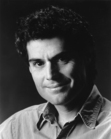Michael Shapiro's Blog
May 27, 2025
A conversation with Stephanie Elizondo Griest, author of the new book, Art Above Everything
Thursday, July 17th, 2025, 6pm, Book Passage, Corte Madera, free!
For young people it can be easy to be idealistic and devote ourselves to art. Then reality — and responsibilities — set in. As a friend said to me shortly after we graduated from college, “Life costs money.”
Stephanie Elizondo Griest’s new book, Art Above Everything: One Woman’s Global Exploration of the Joys and Torments of a Creative Life, explores the sacrifices that artists make to pursue lives devoted to creativity and examines the gifts and challenges of these pursuits.
Her earlier book, Mexican Enough, is a revelation and is a template for what every travel book should be: It’s filled with the voices of local people and their struggles; it’s personal and honest, and it makes us care about the people profiled and the places they inhabit. It’s so much more than a travel book: Elizondo Griest considers her heritage, the nature of belonging, the toll that poverty takes on families when fathers have to go to El Norte to seek work, the risks Mexicans face for being openly gay, and so much more.
When Stephanie asked me to be her partner in conversation, my first thought was, Wouldn’t you rather ask a woman?, but I didn’t want to pass up the opportunity to join my longtime friend on the Book Passage stage.
Here’s the copy for the event from the Book Passage site:
Is the all-encompassing quest to become a self-sustaining artist worth the sacrifices it often requires? Throughout her 20s and 30s, Stephanie Elizondo Griest could not help worrying whether constantly prioritizing her writing over everything else—from postponing children to living nomadically to save on rent—was leading her to fulfillment or regret. After a break-up and health crisis in her early 40s, she decided to turn to other women artists for their perspectives on that perennial question: Is art enough?
Art Above Everything introduces us to legendary writers, visual artists, dancers, and musicians across the globe, who talk intimately about their art, what it requires, what it gifts them, and what it costs them. Opening in a classical Indian dance village, Elizondo Griest goes on to meet more than 100 artists in Qatar, Iceland, Mexico, New Zealand, Cuba, and the United States.
She discovers artists such as Rwandan playwright Hope Azeda, who navigated ethnic tensions as she attempted to bring about reconciliation through theater in the aftermath of genocide; and Romanian painter Florica Prevenda, who got assigned to a provincial factory during Ceaușescu’s dictatorship but never relinquished her brushes.
Art is inheritance, dissent, devotion, revenge, celebration, and more. Yet though the artists’ relationships to their craft is different, their need to create in the face of economic hardship, misogyny, sexual violence, and family ostracization is wholly akin. Bold and inspiring, Art Above Everything never pretends that the artist’s path is easy — but it illuminates the infinite ways we can wield creativity as a vitalizing force.
—
Stephanie Elizondo Griest is a globetrotting writer from the Texas-Mexico borderlands. Her books include Around the Bloc: My Life in Moscow, Beijing, and Havana; Mexican Enough; and All the Agents and Saints: Dispatches from the U.S. Borderlands. She has also written for the New York Times, Washington Post, The Believer, BBC, VQR, and Oxford American.
Her work has won a Margolis Award for Social Justice Reporting, an International Latino Book Award, a PEN Southwest Book Award, and two Lowell Thomas Travel Journalism prizes. Professor of Creative Nonfiction at the University of North Carolina-Chapel Hill, she has performed as both a Moth storyteller and as a literary ambassador for the U.S. State Department. Visit her @SElizondoGriest and www.StephanieElizondoGriest.com.
A conversation with Bridget Crocker, author of the new book, The River’s Daughter
Tuesday, June 17, 6 pm, Book Passage, Corte Madera, free!
As a fellow longtime whitewater raft guide, I share Bridget’s love for rivers and appreciate how moving water can teach us and heal us. I’m thrilled that Bridget asked me to join her in conversation for her event at Book Passage bookstore in Corte Madera on June 17.
Here’s the description of the book and Bridget’s bio. Please join us!
After Bridget Crocker’s parents’ volatile divorce, she moved with her mother from Southern California to Wyoming. Her life was idyllic, growing up in a trailer park on the banks of the Snake River with a stepfather she loved, a new baby brother, and the river as her companion—until her mother suddenly took up a radical new lifestyle, becoming someone Bridget barely recognized. The one constant in her life—the place Bridget felt whole and fully herself—was the river. When she discovered the world of whitewater rafting, she knew she’d found her calling.
On the river, Bridget learned to read the natural world around her and came to know the language of rivers. One of the few female guides on the Snake River, she then traveled to the Zambezi River in Africa, some of the most dangerous whitewater in the world, where she faced death and learned to conquer her fears—both on the water and off. The river taught her how to overcome years of betrayals and abuse, to trust herself, and, finally, how to help heal her family from generational cycles of trauma and poverty.
A beautifully rendered memoir of a woman coming into her own, The River’s Daughter opens us to the possibilities of transformation through nature.
Bridget Crocker is a trailblazer in women’s empowerment within the outdoor industry. A leading whitewater rafting guide, she has led remote river expeditions down many of the world’s greatest river canyons. She is a contributing author to Lonely Planet guidebooks and The Best Women’s Travel Writing series. Her work has been featured in magazines including Men’s Journal, National Geographic Adventure, Trail Runner and Outside, as well as Patagonia’s blog, The Cleanest Line. She lives in Malibu, California.
Event page link: https://www.bookpassage.com/event/bridget-crocker-rivers-daughter-corte-madera-store
May 1, 2025
Why Time Flies: An inquiry into why time feels like it accelerates as we get older, Saturday Evening Post, Jan-Feb 2025
We all feel it, whether we’re 30 or 60 or 90: time feels like it’s speeding up each years. As the Grateful Dead sing in “The Music Never Stopped” … “Lord the band kept us so busy. We forgot about the time.”
Yes, time flies when we’re having fun. Perhaps ironically, the fun times in hindsight can feel like they lasted forever because the days — and nights — were so full. Alan Burdick, author of Why Time Flies, said the sense that time is accelerating isn’t limited to older people. “Everybody at all ages says time is speeding up. You would think that more older people would say it than younger people, but actually everybody at every age says it in just about the same proportion,” he said. “Two-thirds to 80 percent of people say that time is speeding up, whatever age they are. So we’re all experiencing something.”
When I travel, the first two days feel like two weeks. Yet after two weeks, it seems the trip has flown by. But it recollection a week of travel feels like a month, whereas an ordinary month can feel like a week. “This is often referred to as the vacation paradox,” said Dean Buonomano, author of Your Brain Is a Time Machine. “When you’re on vacation, prospectively, as it’s happening, it seems to fly by. But once you’re back home, if the vacation was filled with a lot of new events, then you have a lot of items in memory, and that will give it the subjective feeling of being a long time.”

Author and academic Steve Taylor recalled moving to eastern Germany a year after the fall of the Berlin Wall, when he was in his early 20s. “Everything seemed exhilaratingly different and strange,” he wrote in Time Expansion Experiences. “My life changed radically. Besides the hyper-reality of a new environment, I was living with a partner for the first time. I joined a new band and started to give English lessons to augment my income. … After eight months, I came back to the U.K. on holiday and felt like I had been away for more like eight years. … I was genuinely shocked that the same people were working in the same shops, and that my friends were doing the same jobs. I felt that I had been away for so long that major changes should have occurred in people’s lives.”
To read the full story, click here.
August 1, 2024
Climber with colon cancer seeks to summit Half Dome to raise awareness for screening, Press Democrat, Aug. 1, 2024
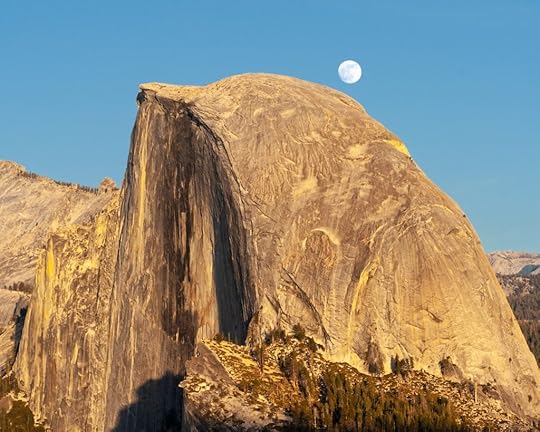
Half Dome photo by Kirk Keeler, 2012.
I met Kirk Keeler in the mid-90s through friends and though we’ve only seen one another occasionally over the years I’ve been impressed by his spirit and commitment to his goals. He’s a dedicated cyclist (we share that) and a talented singer-songwriter who made a heartfelt album of his music 20 years ago. In late 2021, less than 8 months after he and Anna married, he was diagnosed with Stage 4 colon cancer at age 52, yet he’s set an athletic goal that would be tough for a highly fit person half his age.
He’s getting ready to climb Yosemite’s Half Dome with climbing legend Kevin Jorgeson to raise awareness about the importance of colon cancer screening. I wrote about his quest for The Press Democrat. Here’s an excerpt.
To read the full story, click here. There a sidebar on how they plan to climb Half Dome, for the sidebar click here.
Excerpt: “I’ve been lengthening my life with all the chemo treatments, but I’m at the point where it’s just so hard,” Kirk Keeler said, noting he had an allergic reaction during one infusion. “I can only take so much of that poison.” So he quit chemo and worked to get back in shape. “I just want to have quality,” he said. “I want to be at my best.”
And he wants to climb Yosemite’s most seductive rock wall, Half Dome. Not the cable route that about 300 people climb daily, which would be impressive enough. No, Keeler will rope up with renowned climber Kevin Jorgeson, famed for his first ascent of El Capitan’s Dawn Wall, and climb the Snake Dike route on the edge of Half Dome’s face.
The idea of climbing Half Dome, elevation 8,842 feet, hatched two years ago during one of Keeler’s few good days between chemo treatments. “I was feeling good (and thought), wouldn’t it be cool to do Half Dome,” Keeler recalled during a late June conversation at Session climbing gym in Santa Rosa, which was built by Jorgeson.
“You know how you get ideas, good ideas, and then they go away? Well, this one just wouldn’t go away. It just kind of kept nagging at me,” he said. Around this time, Keeler connected with a Davis-based support group called Cancer Champions and met Jen Miramontes, the group’s founder.
Miramontes felt “an immediate connection.” Keeler’s “honesty and willingness to share his true feelings” made a deep impression. Keeler told Miramontes he wanted “to show what a guy with Stage 4 cancer can accomplish,” he said, but he had a “bigger message” to share: If you’re 45 or older, get screened for colon cancer, “because it’s showing up in younger people now.”
When Keeler was so sick from the chemo that he believed he couldn’t get off the couch, Miramontes would encourage him: “Just walk around the house – go outside – go to the end of the street. Do something!”
Even when walking a block felt impossible, Keeler dreamed of scaling Half Dome to raise awareness for cancer screening. One day he shared that dream with Miramontes. When he brought up the Half Dome idea, Miramontes said to him: “You know, you just put that out into the universe, right?”
Keeler said, “Yeah, I did.”
In that moment Miramontes became confident about Kirk’s aspirations: “He’s going to do this,” she thought. “This is going to happen.”
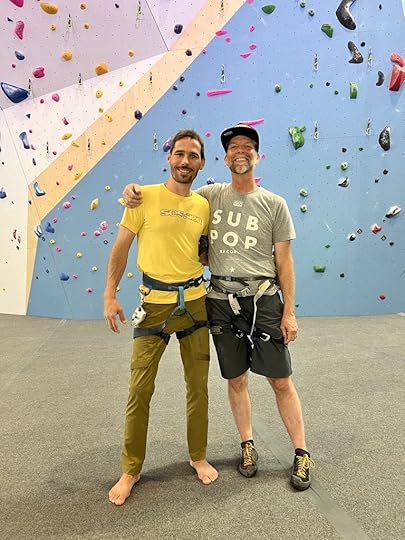
Kevin Jorgeson and Kirk Keeler (right) at Session climbing gym in Santa Rosa
What makes Keeler’s story even more remarkable is that he’s not a big-wall climber. Snake Dike, though not the toughest route up Half Dome — it’s eight pitches (roped segments) and rated or 5.7 — will be the most imposing and challenging climb he’s ever attempted.
Keeler is doing the climb at age 54 while living with colon cancer, with a body that’s endured more hell than most people could imagine. “I was parked on the couch for many, many months,” he said. “I lost so much fitness” and “chemo ravages the body.”
Now he’s “surprisingly feeling really good about where I’m at. I feel on track,” he said on July 26, a week before the climb. “It’s just like eight pitches of low-angle stuff. The crux is the first pitch,” he said. “After that, it’s apparently this incredibly beautiful granite dike that just goes vertically up the dome. All the holds are there. I’m feeling ready for this.”
To read the full story, click here.
There a sidebar on how they plan to climb Half Dome, for the sidebar click here.
July 23, 2024
Journey Toward Everest: Trekking with the son of Tenzing Norgay to Everest Base Camp, Saturday Evening Post, Jan-Feb 2024
In 2018, my wife Jackie and I had the privilege and pleasure of trekking with Jamling Tenzing to Nepal’s Mustang region near Tibet. In 2023, Jamling invited us to share in the celebration of the 70th anniversary of the 1953 ascent of Everest. His father Tenzing Norgay and Edmund Hillary were the first humans to reach the summit of the world’s highest mountain. I’ll never reach that summit. My Everest summit was making it to base camp.
A dear friend, Jan Morris, had been the only journalist on that 1953 expedition and had rushed the news down the mountain to ensure word reach London ahead of the coronation of Queen Elizabeth which led to a glorious celebration in Britain just eight years after WW2.
My story is a day-by-day account of the trek to base camp. Here’s Day 1; to read the full story please click here.
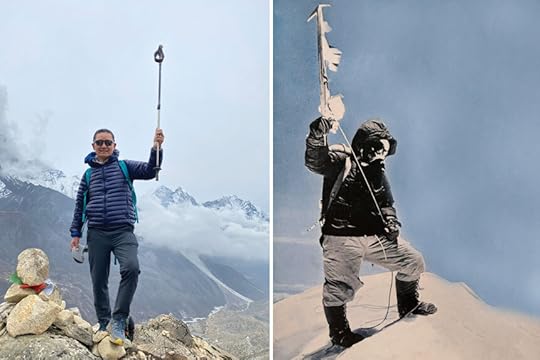
Jamling Tenzing in Namche Bazar, Nepal in 2023. A famous photo of Tenzing Norgay raising his ice axe on the summit of Everest on May 29, 1953.
Day 1Kathmandu to Lukla to Monjo (9,200 feet)
Reading Jan Morris’s Coronation Everest — the exclusive account of the 1953 British expedition that was the first to reach Everest’s summit — I learn that back then Nepal had no roads outside of its capital; the only way to get to Everest Base Camp was to walk 200 miles from Kathmandu. After arduous days of hiking, the climbers crawled into tiny tents, so low they could barely sit up.
Our journey begins quite differently. After three days at the luxurious (by Nepal standards) Hotel Yak & Yeti, where we enjoyed sumptuous buffet breakfasts and sipped gin and tonics at dusk, we fly from Kathmandu to Tenzing Hillary Airport in the vertiginous village of Lukla.
The plane flies lower than nearby mountaintops, zipping between peaks. Then we seem to drop straight down to Lukla’s impossibly short runway, so short that planes can only stop in time thanks to the 12-degree upward slope — the landing is the most frightening of my life. We shoulder our packs and begin our trek.
Six Sherpas hike with us, showing us the way whenever the trail splits and offering to carry our days packs on steep climbs. “If you need to give a bag to a Sherpa, give it to him,” Jamling says. “We want you to get to your destination, with a smile.”
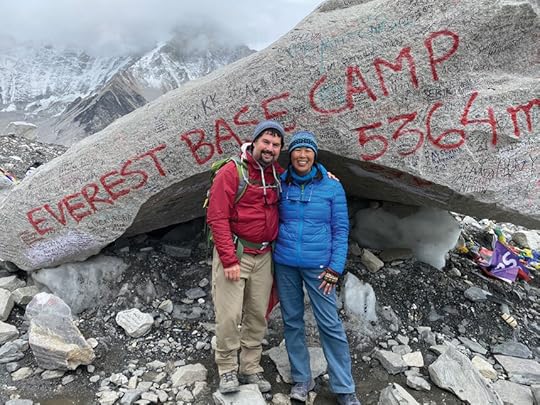
Arriving at Everest base camp after eight days of trekking, with my wife, Jackie Yau.
We share the trail with dzos (rhymes with nose), pack animals that are half yak, half cow whose bells form a euphonic soundtrack to the cinematic views of the snowcapped Himalayan peaks.
The animals, despite being heavily laden, walk faster than we do, and our instructions are clear: When animals pass, always stay to the uphill side of the trail. Dzos and yaks have a nasty habit of knocking tourists off trails and down into the valleys below. We keep our distance and scramble a couple of feet above the trail whenever we see a caravan coming.
February 14, 2024
Lukas Nelson: Don’t ask him about his famous father, Press Democrat, Feb 2024
Most stories about Lukas Nelson start with referencing his popular pop, Willie. So when I interviewed Lukas in advance of his Santa Rosa appearance in early 2024, I made a point to ask a series of questions about his own work, then later in the interview I asked a question about Willie. Big mistake.
“I don’t want to make the interview all about growing up with dad. That’s probably not where we want to go with this. Maybe that’s what the readers want to hear. If that’s the case, then that’s fine, we can just part ways here, but you know, it should be I think about what we’re doing here as a band.”
I quickly pivoted to the rest of my questions about Lukas, his band, and his new album. And in the story, I don’t even name Willie Nelson until the final paragraph. Below are a few excerpts from the story. To read the full story, click here.
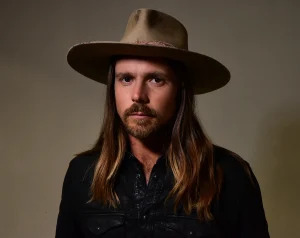
Lukas Nelson photo by Shervin Lainez
“I have a knack for putting myself in others’ shoes when I write,” he said. “I like to … put myself in the mind and the heart and spirit of someone else and try and write from a different perspective sometimes.” …
In 2014, Neil Young invited Nelson and Promise of the Real to be his band, filling the shoes of the incomparable Crazy Horse. They were on Bottle Rock’s main stage with Young in Napa in 2019, ripping through the blistering encore, “Rockin’ in the Free World,” when, to adhere to the curfew, Bottle Rock cut the sound at precisely 10pm. Young appeared momentarily stunned. Then he kept playing without amplification, shouting lyrics through a dead mic.
The crowd of thousands could barely hear Young and the band, but their message was loud and clear. They would not be silenced. “I thought that was pretty rock and roll, the epitome of why you want to play with a guy like Neil,” Nelson said. “Neil wanted to play, and we were backing him up, so we kept going.” …
Nelson believes that music should be “beyond politics and bring people together with more of a focus on the heart, and finding heart, and living in heart and empathy.” Authentic music can “go straight to the heart and the soul. I think that people who aren’t so much in touch with their hearts and souls can have that awakened in them if exposed to a good concert or a good song,” he said.
“I’ve got good friends on both sides of the aisle, and I find it to be really important that my music can reach both of them. I think it’s more effective to try and reach people’s hearts than it is to tell them how to think or what to say or do.”
Nelson spent some of his formative years with his parents and brother living on Maui not far from spiritual leader Ram Dass. “I was trying to get into the art of what being alive was,” he told the Austin American-Statesman. When he was 13, he was reading Hermann Hesse and “already trying to figure out was life was all about.”
March 19, 2023
River Rights Gone Wrong, California water resources a source of conflict, Sierra magazine, Spring 2023
Sierra, the country’s leading environmental magazine, has a front-of-the-book section called Notes from Here and There that’s akin to the New Yorker’s Talk of the Town. It’s an ideal venue for spotlighting personal views on the environment, not my views but those of the most affected people, such as a Karuk tribal elder who told me: “So we’re going through a disaster with all these dead fish—hundreds, thousands of fish floating down the Klamath River—and then the farmers turn around and take half the Shasta River,” Hockaday said. “That was like kicking me in the teeth. It was heartless.”
This is what happened when farmers in upper Northern California began diverting the Shasta River, which feed the Klamath, after a devastating fire in summer 2022. To read the full story in Sierra magazine, click this link: River Rights Gone Wrong.
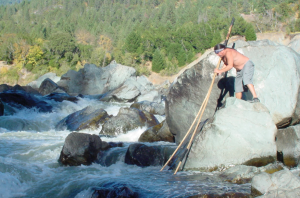
Ron Reed dipnet fishing at Ishi Pishi Falls. Photo courtesy of Karuk Tribe
Sierra, Spring 2023: River Rights Gone Wrong, California water resources a source of conflict
Sierra, the country’s leading environmental magazine, has a front-of-the-book section called Notes from Here and There that’s akin to the New Yorker’s Talk of the Town. It’s an ideal venue for spotlighting personal views on the environment, not my views but those of the most affected people, such as a Karuk tribal elder who told me: “So we’re going through a disaster with all these dead fish—hundreds, thousands of fish floating down the Klamath River—and then the farmers turn around and take half the Shasta River,” Hockaday said. “That was like kicking me in the teeth. It was heartless.”
This is what happened when farmers in upper Northern California began diverting the Shasta River, which feed the Klamath, after a devastating fire in summer 2022. To read the full story in Sierra magazine, click this link: River Rights Gone Wrong.

Ron Reed dipnet fishing at Ishi Pishi Falls. Photo courtesy of Karuk Tribe
October 20, 2022
Hell’s Backbone Grill: An unexpected culinary oasis in southern Utah, The Traveler’s Table, Fall 2022
When I heard from a writer friend that her sister and cooking partner, both former chefs on whitewater rivers trips, had opened a restaurant in southern Utah, I vowed to get there someday. In summer of 2021, after a raft trip on the Green River, my wife and I drove the serpentine blue highways to the tiny hamlet of Boulder, Utah. This is free-range country — we had to stop occasionally for bulls and cows in the road that acted as invincible as their bovine cousins in India. After a long drive we pulled into Boulder (pop. 240) around sunset. It was well worth the effort to reach the most remote fine-dining restaurant in the U.S.
The story, for a magazine called The Traveler’s Table, was originally assigned at 1,500 words, then cut to 1,150 then to 800 as the editor said she was losing pages due to getting fewer ads than expected. Below is my original story in its full glory, click here to see the shorter version on the magazine’s site.
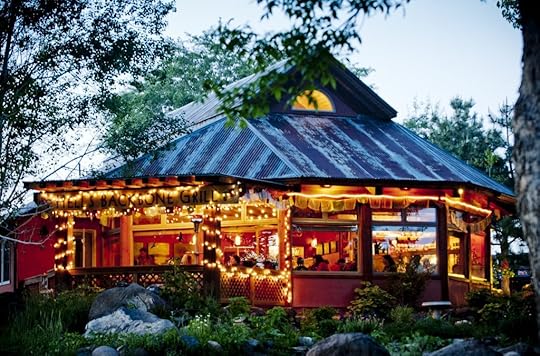
A Culinary Oasis
Generous farm-to-table cuisine perfect after days spent in national parks
By Michael Shapiro
Photo of Hell’s Backbone Grill courtesy of the restaurant
Located in the red-rock splendor of south-central Utah, Hell’s Backbone Grill and Farm is the most remote fine-dining restaurant in the continental United States. Founded by two women who honed their cooking skills on whitewater rafting trips through the Grand Canyon, Hell’s Backbone is a culinary oasis in the high desert.
As my wife and I drove last summer through the undulating canyons of Capitol Reef National Park, we listened to a story in The New Yorker magazine about Hell’s Backbone and its against-all-odds success.
Blake Spalding and Jennifer Castle had never attended culinary school, were liberals in a deeply conservative ranching community, and followed the teachings of Buddhism in a heavily Mormon region.
“We wanted to do clean food, beautifully served, with love and care,” co-founder and chef Blake Spalding told me. The restaurant opened in 2000, in the heart of Grand Staircase Escalante National Monument, which had been designated by President Clinton just four years earlier.
“We were certainly the first rural restaurant to endeavor what we did, and we remain one of the only women-owned, woman-cheffed restaurants that has its own farm and no outside investors,” Spalding said. She’d started cooking for her family when she was eight and, like Castle, by her teens was working as a restaurant cook.
Spalding and Castle wanted to create a restaurant “that I would want to work in and that I would want to eat in.” Their goal has been to host a nightly dinner party where you can get wholesome, flavorful, local food that’s gorgeously prepared and doesn’t cost a fortune. Appetizers typically cost $10 to $15, entrees range from $27 to $44.
In the foreword to Castle and Spalding’s 2004 cookbook, With a Measure of Grace, author Terry Tempest Williams said the two chefs came to Boulder with “baskets of instinct and secrets about the power of food and its potential for glory.”
After dining at Hell’s Backbone she wrote: “What lingers after a slow, thoughtful dinner is love. We are reminded through the creative hands of these believing women that daily renewal is possible through the loving gesture of a meal dreamed and shared.”
Hell’s Backbone Grill, named for a nearby bridge that spans a 1,500-foot-deep canyon, was a semi-finalist in the 2022 James Beard Foundation Awards for Outstanding Restaurant and has received rave reviews from Zagat.
I’d heard about Hell’s Backbone from a savvy travel advisor who said that if we visit Utah, we should stop there. When I wondered if it was on our way, she said authoritatively: “Make it on the way; you’ll be glad you did.”
From Green River, where we stayed while embarking on day trips to Arches and Canyonlands national parks, Google Maps said it’d take 2 hours and 37 minutes to drive to Hell’s Backbone, but that didn’t account for stopping to let free-roaming cattle pass.
We drove through Capitol Reef National Park, then climbed a steep hill with views for miles and miles before descending toward our destination. There’s not much in Boulder: no bank or traffic light or supermarket, just a couple of lodges and one of the most unlikely restaurants in the western U.S.
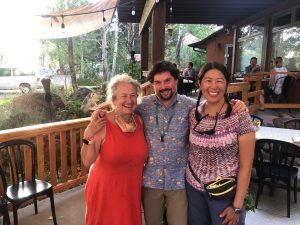
With Blake Spalding chef and co-owner of Hell’s Backbone Grill in Boulder, Utah
Arriving just before dusk, we found Hell’s Backbone illuminated by strings of outdoor lights and garnished with colorful prayer flags. We were seated on the patio right away. (You can now eat indoors as well.)
We were happy to dine outdoors, though at 6,700 feet above sea level, it can get chilly after sunset. After a week of river rafting and long hikes through the stunning canyonlands of the Southwest, my wife and I were ready for some satisfying food.
Castle is more introverted and typically manages the kitchen; Spalding greets guests like old friends, making her way from table to table during the evening.
The restaurant, which seats about 75 people, is casual and unpretentious; we dined on the patio in our shorts. The food is divine: salad with a variety of lettuces from Hell’s Backbone’s nearby farm, Boulder Beef Braise with meat from local ranchers, smoked trout pappardelle.
Hell’s Backbone is all about place, a destination restaurant in the truest sense. The salad dressing was so bright that the flavors sparkled. The beef was hearty and energizing, the trout in the pasta tasted so fresh it tasted like it was caught mere hours before the fish hit the pan.
The exceptional food was enhanced by the breathtaking Grand Staircase Escalante National Monument — the yellow, orange and ochre hues of the surrounding hills glowing deeply in the setting sun.
“It’s a landscape so beautiful, it will forever change your perception of what the American West really looks like,” Spalding said.
Heidi Bourne, a meditation teacher from Northern California, first dined at Hell’s Backbone about 12 years ago and returns often. “I never felt before the way I felt when I walked in that restaurant, which was completely at home,” she said.
“I had this feeling of, Oh, I know this place, I belong here. I can relax and enjoy. And this food is going to be exactly right. I felt the depth of love that goes into creating such wholesome, delicious, creative, vibrant food.”
Boulder (Utah not Colorado, pop. 400 according to the U.S. Census though locals say the true number is around 275), is considered one of the United States’ most remote settlements. Letters were delivered by mule there until the early 1942. Electricity came to Boulder in 1947.
In spring of 2000 before opening the restaurant, Spalding and Castle invited the local community to an open house where they could enjoy Hell’s Backbone’s cuisine for free.
Many locals were skeptical about the young, brash outsiders, but after getting to know them, and after they began hiring the town’s young people, Spalding and Castle were welcomed into the community. Locals dine there regularly.
After 23 seasons — Hell’s Backbone is open from April through November — Spalding says she and Castle now feel a sense of “rootedness” in their adopted home.
“Jen and I just understood the power of an extraordinary landscape and a lovingly prepared meal,” Spalding said. “You’re in this amazing place, it really affects people and opens their hearts.”
After cooking in makeshift kitchens in riverside camps along the Colorado River, Castle and Spalding became business partners.
“We relate to ourselves as two wings of one bird, so everything is deeply collaborative,” Spalding said. “Alone, we’re each one person, but together we’re like five. Everyone thinks we’re a couple. We’re not a couple; we’re excellent business partners and friends.”
Still, creating a restaurant that met their lofty standards and making it financially viable has been “incredibly challenging and complicated.”
They’d thought: “How hard could it be? There’s running water, electricity and a roof.” Later, Spalding said, they realized their “hilarious naiveté.”
Part of the challenge is their commitment to the place they call home. They feature local food of the Southwest; in creating the menu, they ask: “Does this food makes sense here? Is it food that has a relationship to this place?”
When you go to a restaurant in Italy, Spalding said, they’ll serve “Italian jam, Italian ham, Italian lamb.’ They’re proud of what they produce in that region. And there wasn’t a thing like that in Utah.”
Castle grew up in New Mexico and created one of Hell’s Backbone’s most popular items, the Jenchilada, an enchilada filled with green-chili beef or calabacitas (small squashes, the veggie option) in a habanero cream sauce, served with cilantro rice.
Other regional favorites include Three Sisters Posole with black beans and butternut squash and Green Chile Beef Stew with pinto beans and farm carrots.
The menu depends on what’s growing at that time and varies greatly from spring to fall. Some produce, such as grapes used in the Champagne Grape Chicken, are “here and gone,” Spalding said, so you’ll only get them when they’re harvested.
There are favorites available from spring to fall, “like our meatloaf, which is incredibly popular,” she said. “I’ve tried taking meatloaf off the menu, and the customers completely freak out.”
Those who dine at Hell’s Backbone “literally leave with part of Boulder in them,” Spalding said, acknowledging that some items — such as olive oil, cheeses, coffee and wine — come from afar.

Mmmmm pie!
Photo my Michael Shapiro
The restaurant is open for dinner seven days a week, so Castle and Spalding work nearly every day from April through November.
What makes it worthwhile? Spalding said they have a “secret mission.” Every season they ask: “How can we make the world a little bit better with what we have to offer?”
Bourne, the woman who has been traveling from California to Hell’s Backbone for years, said she simply enjoys being in the convivial space Spalding and Castle created.
“It’s such a draw, it’s magnetic,” Bourne said. “The food is so creative. They’re serious about the quality; it’s high cuisine. They’re not messing around.”
The restaurant has made visiting the 1.87-million-acre Grand Staircase Escalante and the surrounding lands “even better because we knew we could get spectacular food,” she said.
When people ask Bourne what her most beloved restaurant is, she instantly replies, “My very, very favorite restaurant anywhere is Hell’s Backbone.”
After concluding our meal with the vanilla-glazed Sour Cherry and Rhubarb Slab Pie, my wife and I wholeheartedly agree. Our next Southwest trip might look like a visit to national parks, but our ultimate pursuit will be to revisit Hell’s Backbone.
— — —
Hell’s Backbone Grill is located in Boulder, Utah, about two hours drive east of Bryce Canyon National Park. Spalding and Castle have written two cookbooks — With a Measure of Grace and This Immeasurable Place — available through www.hellsbackbonegrill.com.
To read more about Blake and Jen and HBG, as well their fight to save nearby Grand Staircase Escalante National Monument, read this profile about them in The New Yorker.
July 18, 2022
Book Passage Travel Writers and Photographers Conference, August 14-17, 2025
Michael Shapiro's Blog
- Michael Shapiro's profile
- 3 followers


